Business Finance Report: Analysis of Financial Concepts and Strategies
VerifiedAdded on 2023/01/12
|11
|3245
|66
Report
AI Summary
This report delves into the core concepts of business finance, providing a comprehensive analysis of working capital, cash flow, profit, receivables, payables, and inventory management. It explores the application of these concepts through a case study, evaluating a company's financial performance and offering practical recommendations for improvement. The report further examines the importance of budgeting, discussing traditional and alternative budgeting methods like rolling budgets and zero-based budgeting. It highlights the benefits and drawbacks of each approach, providing insights into their application in supporting business objectives. The report emphasizes the significance of effective financial planning and management in achieving desired outcomes for businesses.
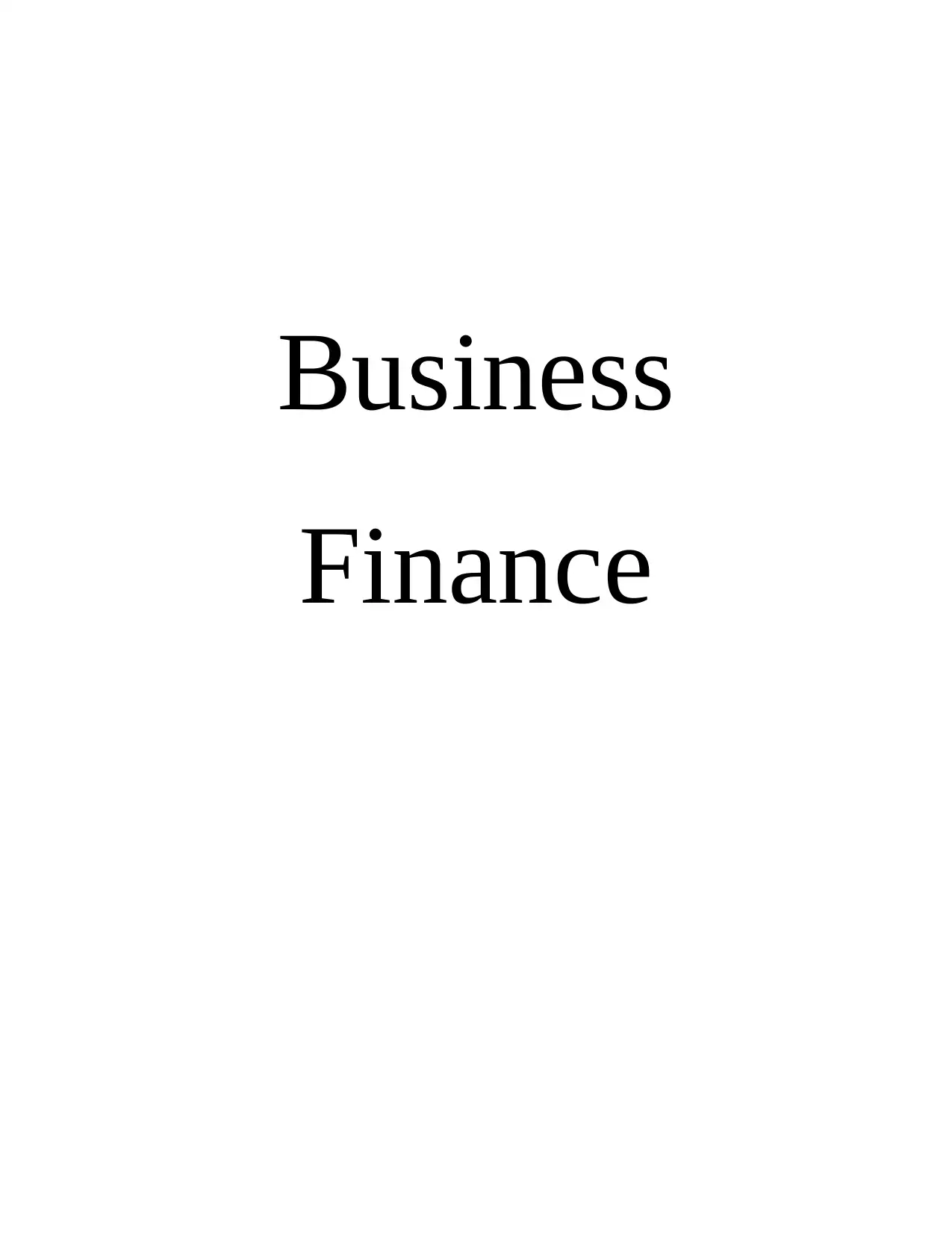
Business
Finance
Finance
Paraphrase This Document
Need a fresh take? Get an instant paraphrase of this document with our AI Paraphraser
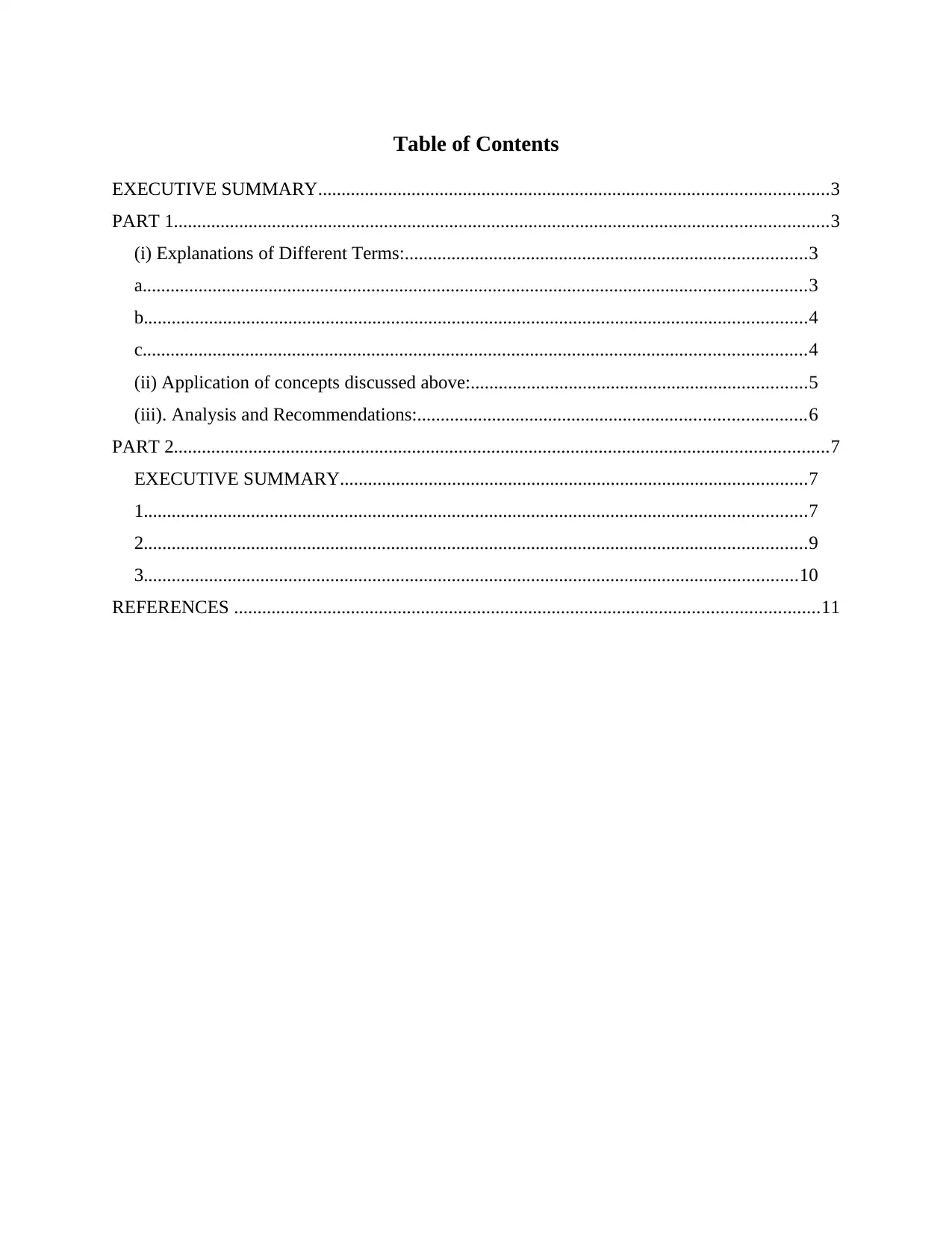
Table of Contents
EXECUTIVE SUMMARY.............................................................................................................3
PART 1............................................................................................................................................3
(i) Explanations of Different Terms:......................................................................................3
a..............................................................................................................................................3
b..............................................................................................................................................4
c..............................................................................................................................................4
(ii) Application of concepts discussed above:........................................................................5
(iii). Analysis and Recommendations:...................................................................................6
PART 2............................................................................................................................................7
EXECUTIVE SUMMARY....................................................................................................7
1..............................................................................................................................................7
2..............................................................................................................................................9
3............................................................................................................................................10
REFERENCES .............................................................................................................................11
EXECUTIVE SUMMARY.............................................................................................................3
PART 1............................................................................................................................................3
(i) Explanations of Different Terms:......................................................................................3
a..............................................................................................................................................3
b..............................................................................................................................................4
c..............................................................................................................................................4
(ii) Application of concepts discussed above:........................................................................5
(iii). Analysis and Recommendations:...................................................................................6
PART 2............................................................................................................................................7
EXECUTIVE SUMMARY....................................................................................................7
1..............................................................................................................................................7
2..............................................................................................................................................9
3............................................................................................................................................10
REFERENCES .............................................................................................................................11
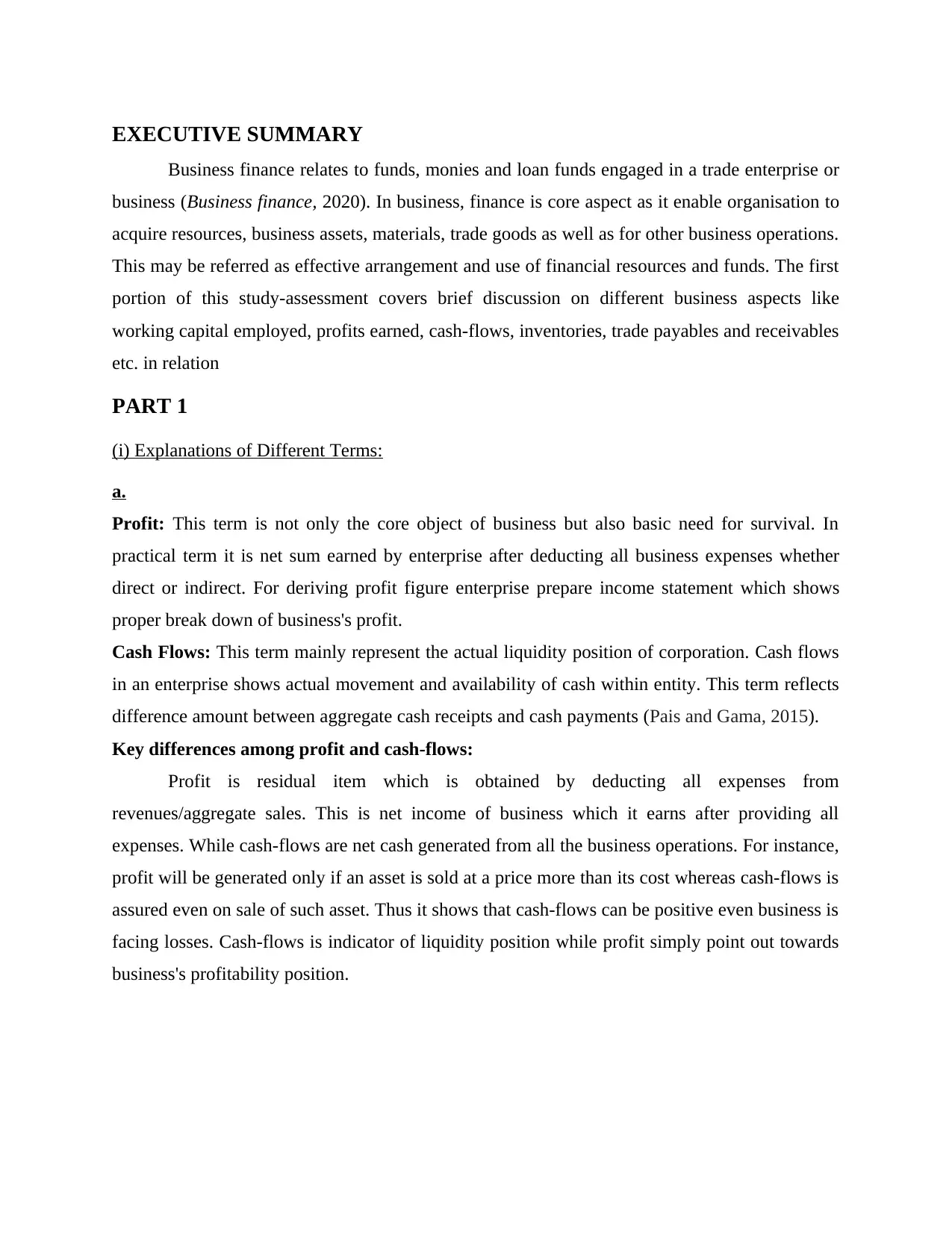
EXECUTIVE SUMMARY
Business finance relates to funds, monies and loan funds engaged in a trade enterprise or
business (Business finance, 2020). In business, finance is core aspect as it enable organisation to
acquire resources, business assets, materials, trade goods as well as for other business operations.
This may be referred as effective arrangement and use of financial resources and funds. The first
portion of this study-assessment covers brief discussion on different business aspects like
working capital employed, profits earned, cash-flows, inventories, trade payables and receivables
etc. in relation
PART 1
(i) Explanations of Different Terms:
a.
Profit: This term is not only the core object of business but also basic need for survival. In
practical term it is net sum earned by enterprise after deducting all business expenses whether
direct or indirect. For deriving profit figure enterprise prepare income statement which shows
proper break down of business's profit.
Cash Flows: This term mainly represent the actual liquidity position of corporation. Cash flows
in an enterprise shows actual movement and availability of cash within entity. This term reflects
difference amount between aggregate cash receipts and cash payments (Pais and Gama, 2015).
Key differences among profit and cash-flows:
Profit is residual item which is obtained by deducting all expenses from
revenues/aggregate sales. This is net income of business which it earns after providing all
expenses. While cash-flows are net cash generated from all the business operations. For instance,
profit will be generated only if an asset is sold at a price more than its cost whereas cash-flows is
assured even on sale of such asset. Thus it shows that cash-flows can be positive even business is
facing losses. Cash-flows is indicator of liquidity position while profit simply point out towards
business's profitability position.
Business finance relates to funds, monies and loan funds engaged in a trade enterprise or
business (Business finance, 2020). In business, finance is core aspect as it enable organisation to
acquire resources, business assets, materials, trade goods as well as for other business operations.
This may be referred as effective arrangement and use of financial resources and funds. The first
portion of this study-assessment covers brief discussion on different business aspects like
working capital employed, profits earned, cash-flows, inventories, trade payables and receivables
etc. in relation
PART 1
(i) Explanations of Different Terms:
a.
Profit: This term is not only the core object of business but also basic need for survival. In
practical term it is net sum earned by enterprise after deducting all business expenses whether
direct or indirect. For deriving profit figure enterprise prepare income statement which shows
proper break down of business's profit.
Cash Flows: This term mainly represent the actual liquidity position of corporation. Cash flows
in an enterprise shows actual movement and availability of cash within entity. This term reflects
difference amount between aggregate cash receipts and cash payments (Pais and Gama, 2015).
Key differences among profit and cash-flows:
Profit is residual item which is obtained by deducting all expenses from
revenues/aggregate sales. This is net income of business which it earns after providing all
expenses. While cash-flows are net cash generated from all the business operations. For instance,
profit will be generated only if an asset is sold at a price more than its cost whereas cash-flows is
assured even on sale of such asset. Thus it shows that cash-flows can be positive even business is
facing losses. Cash-flows is indicator of liquidity position while profit simply point out towards
business's profitability position.
⊘ This is a preview!⊘
Do you want full access?
Subscribe today to unlock all pages.

Trusted by 1+ million students worldwide

b.
Working Capital: Working capital known to be money the company uses to fund current assets.
This essentially reflects available funds to the organization to support routine functions, i.e. day-
to-day commercial activities. This helps to assess the firm's liquidity, i.e. how easily company
can offset short-term debts with short-term assets. This means the existing current-assets excess
over aggregate current liabilities. A positive net working capital represents the willingness of the
corporation to pay short-term obligations, while a negative working capital implies the failure of
the business to meet short-term commitments/liabilities.
Receivables:
Accounts receivable shows debt owed by consumers/customers to the company with regard to
sales on credit of products or services. As credit sales lead to an rise in the entity's revenues (sale
revenues) as well as assets (receivable), these assets should be debited whereas income should be
credited in accounts (Cardoş, 2014). As that is an sum of which enterprise has a legitimate claim
against the client, and client is therefore obliged to pay that same to an organization, it is listed as
Current Asset in the corporation's balance sheet.
Inventories:
Inventories implies to collection of raw materials, WIPs, unprocessed goods, processed goods
and finished goods which are still not sold. These are regarded as liquid assets as these can
normally be smoothly converted into cash. Stock/inventories, in business, any form of assets kept
in stock, comprising ready-to-sell finished products, products in the manufacturing process,
manufactured goods, and products which will be used in production processes for sale. Stocks
appear as asset on a firm's balance sheet.
Payables:
Accounts payable are liabilities which businesses owe to business vendors as a consequence of
buying goods on credit. Accounts payable are forms of current obligations/liabilities that are
usually incurred within one year-period. Accounts Payable are elements of balance sheet and
their identification is based on principle of accrual. Unless the reports of entity's accounting use
cash base, so account payable does not apply.
c.
In what manner fluctuations in Working Capital impact Cash-flows:
Working Capital: Working capital known to be money the company uses to fund current assets.
This essentially reflects available funds to the organization to support routine functions, i.e. day-
to-day commercial activities. This helps to assess the firm's liquidity, i.e. how easily company
can offset short-term debts with short-term assets. This means the existing current-assets excess
over aggregate current liabilities. A positive net working capital represents the willingness of the
corporation to pay short-term obligations, while a negative working capital implies the failure of
the business to meet short-term commitments/liabilities.
Receivables:
Accounts receivable shows debt owed by consumers/customers to the company with regard to
sales on credit of products or services. As credit sales lead to an rise in the entity's revenues (sale
revenues) as well as assets (receivable), these assets should be debited whereas income should be
credited in accounts (Cardoş, 2014). As that is an sum of which enterprise has a legitimate claim
against the client, and client is therefore obliged to pay that same to an organization, it is listed as
Current Asset in the corporation's balance sheet.
Inventories:
Inventories implies to collection of raw materials, WIPs, unprocessed goods, processed goods
and finished goods which are still not sold. These are regarded as liquid assets as these can
normally be smoothly converted into cash. Stock/inventories, in business, any form of assets kept
in stock, comprising ready-to-sell finished products, products in the manufacturing process,
manufactured goods, and products which will be used in production processes for sale. Stocks
appear as asset on a firm's balance sheet.
Payables:
Accounts payable are liabilities which businesses owe to business vendors as a consequence of
buying goods on credit. Accounts payable are forms of current obligations/liabilities that are
usually incurred within one year-period. Accounts Payable are elements of balance sheet and
their identification is based on principle of accrual. Unless the reports of entity's accounting use
cash base, so account payable does not apply.
c.
In what manner fluctuations in Working Capital impact Cash-flows:
Paraphrase This Document
Need a fresh take? Get an instant paraphrase of this document with our AI Paraphraser
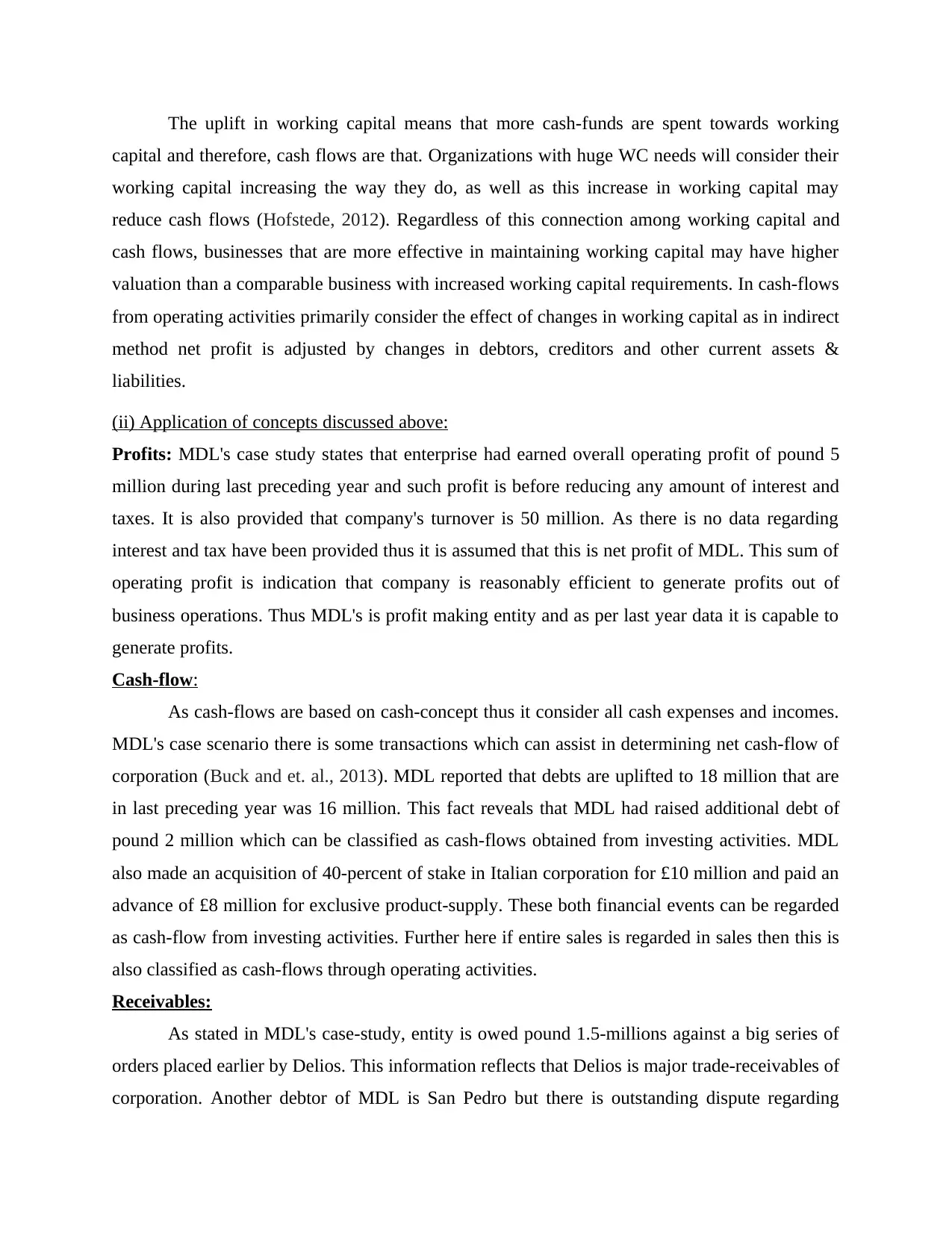
The uplift in working capital means that more cash-funds are spent towards working
capital and therefore, cash flows are that. Organizations with huge WC needs will consider their
working capital increasing the way they do, as well as this increase in working capital may
reduce cash flows (Hofstede, 2012). Regardless of this connection among working capital and
cash flows, businesses that are more effective in maintaining working capital may have higher
valuation than a comparable business with increased working capital requirements. In cash-flows
from operating activities primarily consider the effect of changes in working capital as in indirect
method net profit is adjusted by changes in debtors, creditors and other current assets &
liabilities.
(ii) Application of concepts discussed above:
Profits: MDL's case study states that enterprise had earned overall operating profit of pound 5
million during last preceding year and such profit is before reducing any amount of interest and
taxes. It is also provided that company's turnover is 50 million. As there is no data regarding
interest and tax have been provided thus it is assumed that this is net profit of MDL. This sum of
operating profit is indication that company is reasonably efficient to generate profits out of
business operations. Thus MDL's is profit making entity and as per last year data it is capable to
generate profits.
Cash-flow:
As cash-flows are based on cash-concept thus it consider all cash expenses and incomes.
MDL's case scenario there is some transactions which can assist in determining net cash-flow of
corporation (Buck and et. al., 2013). MDL reported that debts are uplifted to 18 million that are
in last preceding year was 16 million. This fact reveals that MDL had raised additional debt of
pound 2 million which can be classified as cash-flows obtained from investing activities. MDL
also made an acquisition of 40-percent of stake in Italian corporation for £10 million and paid an
advance of £8 million for exclusive product-supply. These both financial events can be regarded
as cash-flow from investing activities. Further here if entire sales is regarded in sales then this is
also classified as cash-flows through operating activities.
Receivables:
As stated in MDL's case-study, entity is owed pound 1.5-millions against a big series of
orders placed earlier by Delios. This information reflects that Delios is major trade-receivables of
corporation. Another debtor of MDL is San Pedro but there is outstanding dispute regarding
capital and therefore, cash flows are that. Organizations with huge WC needs will consider their
working capital increasing the way they do, as well as this increase in working capital may
reduce cash flows (Hofstede, 2012). Regardless of this connection among working capital and
cash flows, businesses that are more effective in maintaining working capital may have higher
valuation than a comparable business with increased working capital requirements. In cash-flows
from operating activities primarily consider the effect of changes in working capital as in indirect
method net profit is adjusted by changes in debtors, creditors and other current assets &
liabilities.
(ii) Application of concepts discussed above:
Profits: MDL's case study states that enterprise had earned overall operating profit of pound 5
million during last preceding year and such profit is before reducing any amount of interest and
taxes. It is also provided that company's turnover is 50 million. As there is no data regarding
interest and tax have been provided thus it is assumed that this is net profit of MDL. This sum of
operating profit is indication that company is reasonably efficient to generate profits out of
business operations. Thus MDL's is profit making entity and as per last year data it is capable to
generate profits.
Cash-flow:
As cash-flows are based on cash-concept thus it consider all cash expenses and incomes.
MDL's case scenario there is some transactions which can assist in determining net cash-flow of
corporation (Buck and et. al., 2013). MDL reported that debts are uplifted to 18 million that are
in last preceding year was 16 million. This fact reveals that MDL had raised additional debt of
pound 2 million which can be classified as cash-flows obtained from investing activities. MDL
also made an acquisition of 40-percent of stake in Italian corporation for £10 million and paid an
advance of £8 million for exclusive product-supply. These both financial events can be regarded
as cash-flow from investing activities. Further here if entire sales is regarded in sales then this is
also classified as cash-flows through operating activities.
Receivables:
As stated in MDL's case-study, entity is owed pound 1.5-millions against a big series of
orders placed earlier by Delios. This information reflects that Delios is major trade-receivables of
corporation. Another debtor of MDL is San Pedro but there is outstanding dispute regarding
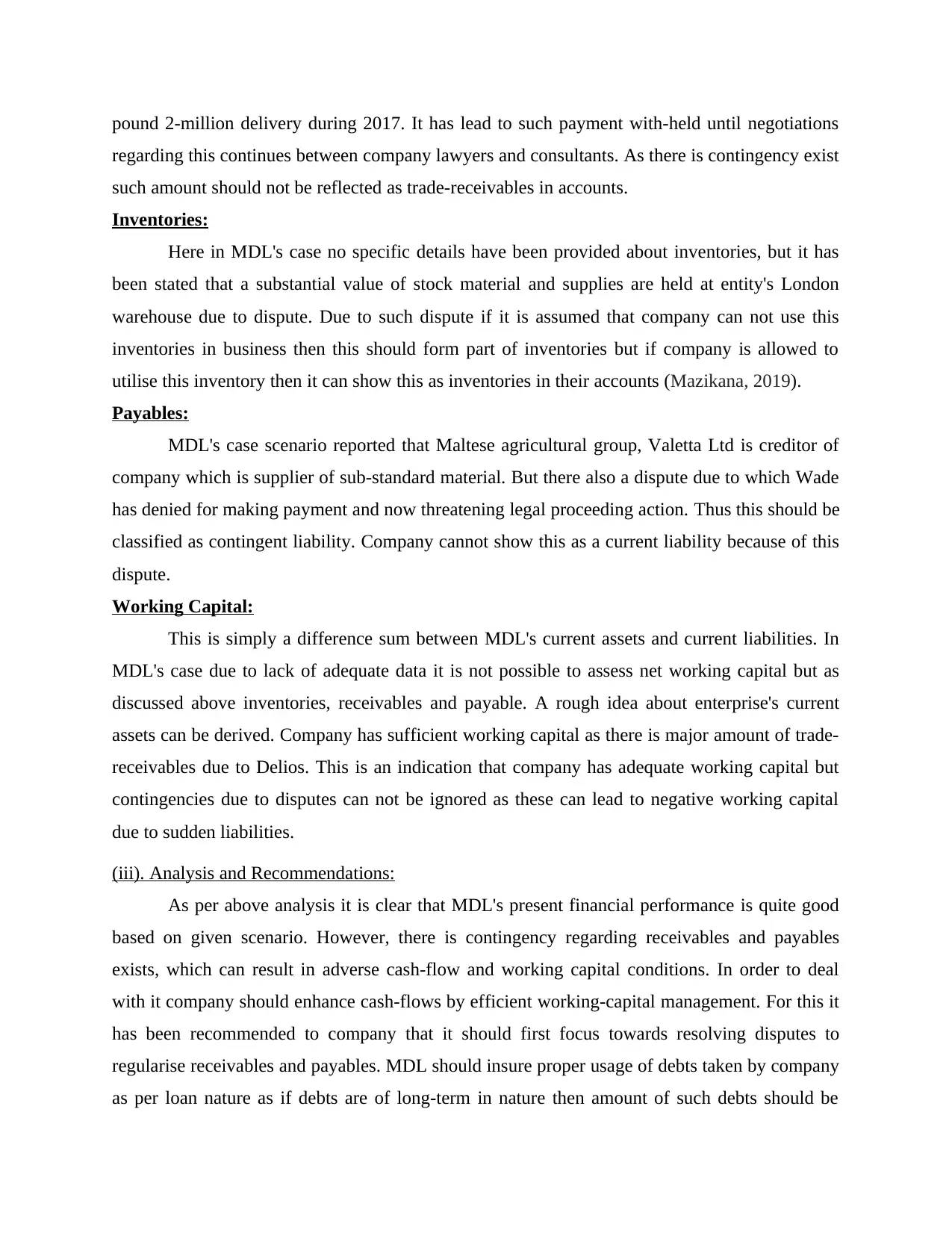
pound 2-million delivery during 2017. It has lead to such payment with-held until negotiations
regarding this continues between company lawyers and consultants. As there is contingency exist
such amount should not be reflected as trade-receivables in accounts.
Inventories:
Here in MDL's case no specific details have been provided about inventories, but it has
been stated that a substantial value of stock material and supplies are held at entity's London
warehouse due to dispute. Due to such dispute if it is assumed that company can not use this
inventories in business then this should form part of inventories but if company is allowed to
utilise this inventory then it can show this as inventories in their accounts (Mazikana, 2019).
Payables:
MDL's case scenario reported that Maltese agricultural group, Valetta Ltd is creditor of
company which is supplier of sub-standard material. But there also a dispute due to which Wade
has denied for making payment and now threatening legal proceeding action. Thus this should be
classified as contingent liability. Company cannot show this as a current liability because of this
dispute.
Working Capital:
This is simply a difference sum between MDL's current assets and current liabilities. In
MDL's case due to lack of adequate data it is not possible to assess net working capital but as
discussed above inventories, receivables and payable. A rough idea about enterprise's current
assets can be derived. Company has sufficient working capital as there is major amount of trade-
receivables due to Delios. This is an indication that company has adequate working capital but
contingencies due to disputes can not be ignored as these can lead to negative working capital
due to sudden liabilities.
(iii). Analysis and Recommendations:
As per above analysis it is clear that MDL's present financial performance is quite good
based on given scenario. However, there is contingency regarding receivables and payables
exists, which can result in adverse cash-flow and working capital conditions. In order to deal
with it company should enhance cash-flows by efficient working-capital management. For this it
has been recommended to company that it should first focus towards resolving disputes to
regularise receivables and payables. MDL should insure proper usage of debts taken by company
as per loan nature as if debts are of long-term in nature then amount of such debts should be
regarding this continues between company lawyers and consultants. As there is contingency exist
such amount should not be reflected as trade-receivables in accounts.
Inventories:
Here in MDL's case no specific details have been provided about inventories, but it has
been stated that a substantial value of stock material and supplies are held at entity's London
warehouse due to dispute. Due to such dispute if it is assumed that company can not use this
inventories in business then this should form part of inventories but if company is allowed to
utilise this inventory then it can show this as inventories in their accounts (Mazikana, 2019).
Payables:
MDL's case scenario reported that Maltese agricultural group, Valetta Ltd is creditor of
company which is supplier of sub-standard material. But there also a dispute due to which Wade
has denied for making payment and now threatening legal proceeding action. Thus this should be
classified as contingent liability. Company cannot show this as a current liability because of this
dispute.
Working Capital:
This is simply a difference sum between MDL's current assets and current liabilities. In
MDL's case due to lack of adequate data it is not possible to assess net working capital but as
discussed above inventories, receivables and payable. A rough idea about enterprise's current
assets can be derived. Company has sufficient working capital as there is major amount of trade-
receivables due to Delios. This is an indication that company has adequate working capital but
contingencies due to disputes can not be ignored as these can lead to negative working capital
due to sudden liabilities.
(iii). Analysis and Recommendations:
As per above analysis it is clear that MDL's present financial performance is quite good
based on given scenario. However, there is contingency regarding receivables and payables
exists, which can result in adverse cash-flow and working capital conditions. In order to deal
with it company should enhance cash-flows by efficient working-capital management. For this it
has been recommended to company that it should first focus towards resolving disputes to
regularise receivables and payables. MDL should insure proper usage of debts taken by company
as per loan nature as if debts are of long-term in nature then amount of such debts should be
⊘ This is a preview!⊘
Do you want full access?
Subscribe today to unlock all pages.

Trusted by 1+ million students worldwide
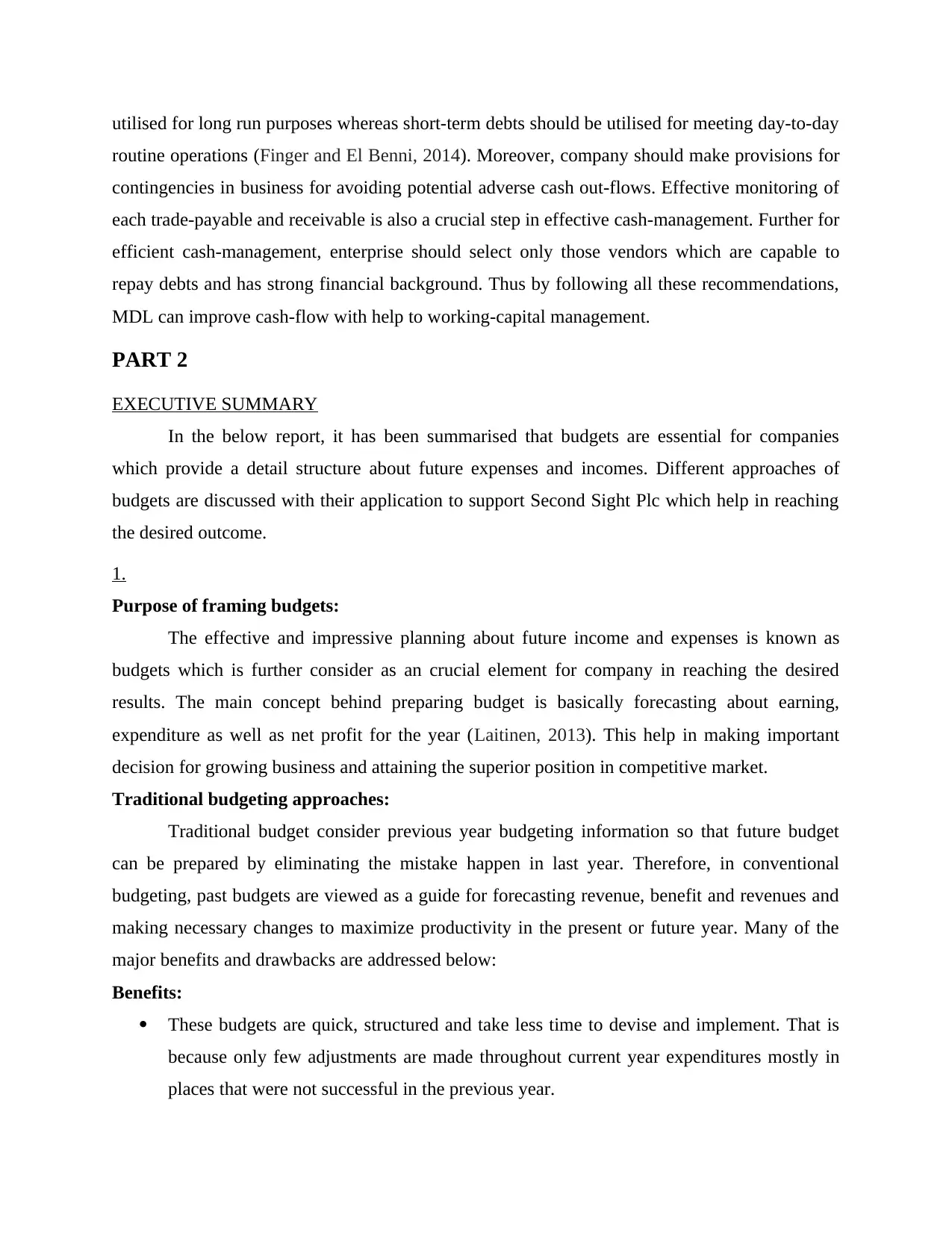
utilised for long run purposes whereas short-term debts should be utilised for meeting day-to-day
routine operations (Finger and El Benni, 2014). Moreover, company should make provisions for
contingencies in business for avoiding potential adverse cash out-flows. Effective monitoring of
each trade-payable and receivable is also a crucial step in effective cash-management. Further for
efficient cash-management, enterprise should select only those vendors which are capable to
repay debts and has strong financial background. Thus by following all these recommendations,
MDL can improve cash-flow with help to working-capital management.
PART 2
EXECUTIVE SUMMARY
In the below report, it has been summarised that budgets are essential for companies
which provide a detail structure about future expenses and incomes. Different approaches of
budgets are discussed with their application to support Second Sight Plc which help in reaching
the desired outcome.
1.
Purpose of framing budgets:
The effective and impressive planning about future income and expenses is known as
budgets which is further consider as an crucial element for company in reaching the desired
results. The main concept behind preparing budget is basically forecasting about earning,
expenditure as well as net profit for the year (Laitinen, 2013). This help in making important
decision for growing business and attaining the superior position in competitive market.
Traditional budgeting approaches:
Traditional budget consider previous year budgeting information so that future budget
can be prepared by eliminating the mistake happen in last year. Therefore, in conventional
budgeting, past budgets are viewed as a guide for forecasting revenue, benefit and revenues and
making necessary changes to maximize productivity in the present or future year. Many of the
major benefits and drawbacks are addressed below:
Benefits:
These budgets are quick, structured and take less time to devise and implement. That is
because only few adjustments are made throughout current year expenditures mostly in
places that were not successful in the previous year.
routine operations (Finger and El Benni, 2014). Moreover, company should make provisions for
contingencies in business for avoiding potential adverse cash out-flows. Effective monitoring of
each trade-payable and receivable is also a crucial step in effective cash-management. Further for
efficient cash-management, enterprise should select only those vendors which are capable to
repay debts and has strong financial background. Thus by following all these recommendations,
MDL can improve cash-flow with help to working-capital management.
PART 2
EXECUTIVE SUMMARY
In the below report, it has been summarised that budgets are essential for companies
which provide a detail structure about future expenses and incomes. Different approaches of
budgets are discussed with their application to support Second Sight Plc which help in reaching
the desired outcome.
1.
Purpose of framing budgets:
The effective and impressive planning about future income and expenses is known as
budgets which is further consider as an crucial element for company in reaching the desired
results. The main concept behind preparing budget is basically forecasting about earning,
expenditure as well as net profit for the year (Laitinen, 2013). This help in making important
decision for growing business and attaining the superior position in competitive market.
Traditional budgeting approaches:
Traditional budget consider previous year budgeting information so that future budget
can be prepared by eliminating the mistake happen in last year. Therefore, in conventional
budgeting, past budgets are viewed as a guide for forecasting revenue, benefit and revenues and
making necessary changes to maximize productivity in the present or future year. Many of the
major benefits and drawbacks are addressed below:
Benefits:
These budgets are quick, structured and take less time to devise and implement. That is
because only few adjustments are made throughout current year expenditures mostly in
places that were not successful in the previous year.
Paraphrase This Document
Need a fresh take? Get an instant paraphrase of this document with our AI Paraphraser
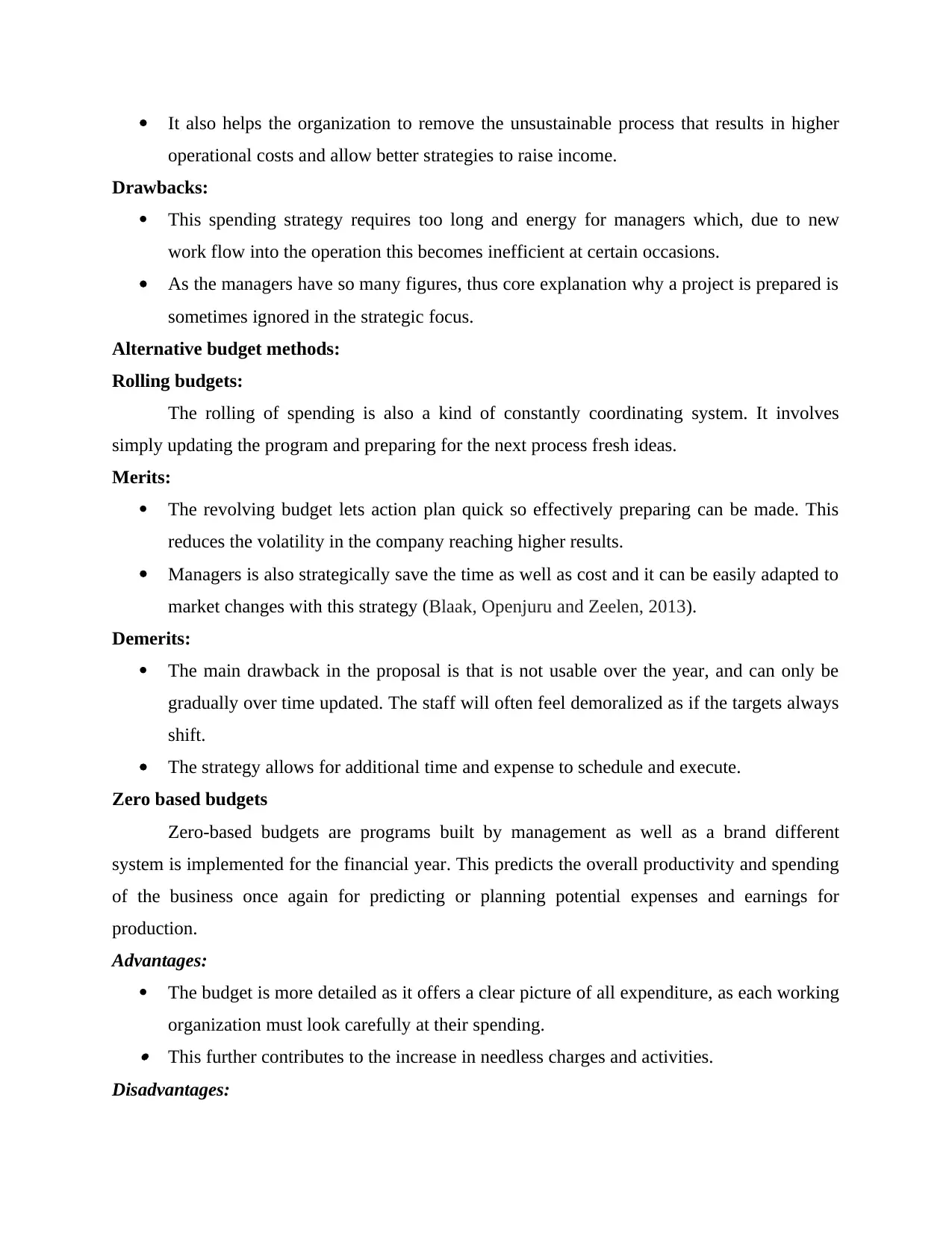
It also helps the organization to remove the unsustainable process that results in higher
operational costs and allow better strategies to raise income.
Drawbacks:
This spending strategy requires too long and energy for managers which, due to new
work flow into the operation this becomes inefficient at certain occasions.
As the managers have so many figures, thus core explanation why a project is prepared is
sometimes ignored in the strategic focus.
Alternative budget methods:
Rolling budgets:
The rolling of spending is also a kind of constantly coordinating system. It involves
simply updating the program and preparing for the next process fresh ideas.
Merits:
The revolving budget lets action plan quick so effectively preparing can be made. This
reduces the volatility in the company reaching higher results.
Managers is also strategically save the time as well as cost and it can be easily adapted to
market changes with this strategy (Blaak, Openjuru and Zeelen, 2013).
Demerits:
The main drawback in the proposal is that is not usable over the year, and can only be
gradually over time updated. The staff will often feel demoralized as if the targets always
shift.
The strategy allows for additional time and expense to schedule and execute.
Zero based budgets
Zero-based budgets are programs built by management as well as a brand different
system is implemented for the financial year. This predicts the overall productivity and spending
of the business once again for predicting or planning potential expenses and earnings for
production.
Advantages:
The budget is more detailed as it offers a clear picture of all expenditure, as each working
organization must look carefully at their spending. This further contributes to the increase in needless charges and activities.
Disadvantages:
operational costs and allow better strategies to raise income.
Drawbacks:
This spending strategy requires too long and energy for managers which, due to new
work flow into the operation this becomes inefficient at certain occasions.
As the managers have so many figures, thus core explanation why a project is prepared is
sometimes ignored in the strategic focus.
Alternative budget methods:
Rolling budgets:
The rolling of spending is also a kind of constantly coordinating system. It involves
simply updating the program and preparing for the next process fresh ideas.
Merits:
The revolving budget lets action plan quick so effectively preparing can be made. This
reduces the volatility in the company reaching higher results.
Managers is also strategically save the time as well as cost and it can be easily adapted to
market changes with this strategy (Blaak, Openjuru and Zeelen, 2013).
Demerits:
The main drawback in the proposal is that is not usable over the year, and can only be
gradually over time updated. The staff will often feel demoralized as if the targets always
shift.
The strategy allows for additional time and expense to schedule and execute.
Zero based budgets
Zero-based budgets are programs built by management as well as a brand different
system is implemented for the financial year. This predicts the overall productivity and spending
of the business once again for predicting or planning potential expenses and earnings for
production.
Advantages:
The budget is more detailed as it offers a clear picture of all expenditure, as each working
organization must look carefully at their spending. This further contributes to the increase in needless charges and activities.
Disadvantages:
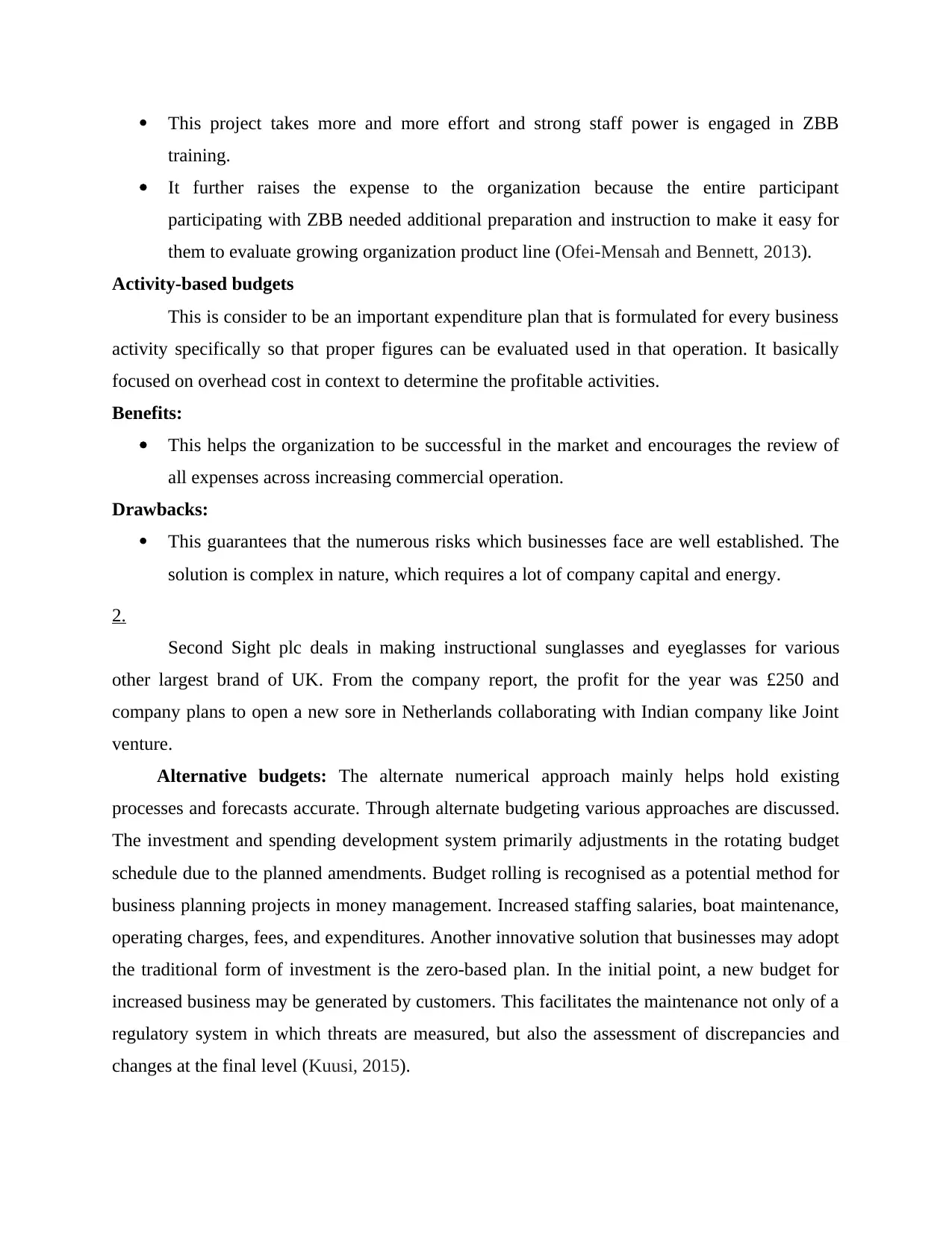
This project takes more and more effort and strong staff power is engaged in ZBB
training.
It further raises the expense to the organization because the entire participant
participating with ZBB needed additional preparation and instruction to make it easy for
them to evaluate growing organization product line (Ofei-Mensah and Bennett, 2013).
Activity-based budgets
This is consider to be an important expenditure plan that is formulated for every business
activity specifically so that proper figures can be evaluated used in that operation. It basically
focused on overhead cost in context to determine the profitable activities.
Benefits:
This helps the organization to be successful in the market and encourages the review of
all expenses across increasing commercial operation.
Drawbacks:
This guarantees that the numerous risks which businesses face are well established. The
solution is complex in nature, which requires a lot of company capital and energy.
2.
Second Sight plc deals in making instructional sunglasses and eyeglasses for various
other largest brand of UK. From the company report, the profit for the year was £250 and
company plans to open a new sore in Netherlands collaborating with Indian company like Joint
venture.
Alternative budgets: The alternate numerical approach mainly helps hold existing
processes and forecasts accurate. Through alternate budgeting various approaches are discussed.
The investment and spending development system primarily adjustments in the rotating budget
schedule due to the planned amendments. Budget rolling is recognised as a potential method for
business planning projects in money management. Increased staffing salaries, boat maintenance,
operating charges, fees, and expenditures. Another innovative solution that businesses may adopt
the traditional form of investment is the zero-based plan. In the initial point, a new budget for
increased business may be generated by customers. This facilitates the maintenance not only of a
regulatory system in which threats are measured, but also the assessment of discrepancies and
changes at the final level (Kuusi, 2015).
training.
It further raises the expense to the organization because the entire participant
participating with ZBB needed additional preparation and instruction to make it easy for
them to evaluate growing organization product line (Ofei-Mensah and Bennett, 2013).
Activity-based budgets
This is consider to be an important expenditure plan that is formulated for every business
activity specifically so that proper figures can be evaluated used in that operation. It basically
focused on overhead cost in context to determine the profitable activities.
Benefits:
This helps the organization to be successful in the market and encourages the review of
all expenses across increasing commercial operation.
Drawbacks:
This guarantees that the numerous risks which businesses face are well established. The
solution is complex in nature, which requires a lot of company capital and energy.
2.
Second Sight plc deals in making instructional sunglasses and eyeglasses for various
other largest brand of UK. From the company report, the profit for the year was £250 and
company plans to open a new sore in Netherlands collaborating with Indian company like Joint
venture.
Alternative budgets: The alternate numerical approach mainly helps hold existing
processes and forecasts accurate. Through alternate budgeting various approaches are discussed.
The investment and spending development system primarily adjustments in the rotating budget
schedule due to the planned amendments. Budget rolling is recognised as a potential method for
business planning projects in money management. Increased staffing salaries, boat maintenance,
operating charges, fees, and expenditures. Another innovative solution that businesses may adopt
the traditional form of investment is the zero-based plan. In the initial point, a new budget for
increased business may be generated by customers. This facilitates the maintenance not only of a
regulatory system in which threats are measured, but also the assessment of discrepancies and
changes at the final level (Kuusi, 2015).
⊘ This is a preview!⊘
Do you want full access?
Subscribe today to unlock all pages.

Trusted by 1+ million students worldwide

Traditional budgeting: The concept of traditional budget is depended on prediction of
previous year financial position. A conventional approach to predict spending is regarded as
helping to create stability in an organizational context. This centralizes expense forecasts, which
lets bookkeepers create an effective system for expense detection. In the traditional budget
method the auditor used where forecasts are based on last year's financial results. Revenue for
the last full year is expected to be £ 250 million. The demand forecasts have to be taken into
consideration in the course of planning the system through the integration of new channels with
Indian business in a new Neatherland region.
3.
Second Sight Plc type will also incorporate the alternate expenditure process to prepare
for potential revenue and expenditures (Laitinen, 2013). It is for various factors which render that
alternative budgeting is much more productive. Likewise:
This help in linking and arranging Second Sight Plc's revenue and expenditures, as in the
respective growth plan for the situation, may be sufficient for the annual budget.
Additionally, Performance Scorecard methods can be used to analyse the expenditure
planned.
The rolling budget is much more productive than the set schedules, because they can be
adjusted and revised based on the company mission, consumer situations and economic
conditions needed.
Moreover, company can also eliminate the unnecessary project details by making use of
KPI technique that help to make better decision in order to increase the overall
profitability.
previous year financial position. A conventional approach to predict spending is regarded as
helping to create stability in an organizational context. This centralizes expense forecasts, which
lets bookkeepers create an effective system for expense detection. In the traditional budget
method the auditor used where forecasts are based on last year's financial results. Revenue for
the last full year is expected to be £ 250 million. The demand forecasts have to be taken into
consideration in the course of planning the system through the integration of new channels with
Indian business in a new Neatherland region.
3.
Second Sight Plc type will also incorporate the alternate expenditure process to prepare
for potential revenue and expenditures (Laitinen, 2013). It is for various factors which render that
alternative budgeting is much more productive. Likewise:
This help in linking and arranging Second Sight Plc's revenue and expenditures, as in the
respective growth plan for the situation, may be sufficient for the annual budget.
Additionally, Performance Scorecard methods can be used to analyse the expenditure
planned.
The rolling budget is much more productive than the set schedules, because they can be
adjusted and revised based on the company mission, consumer situations and economic
conditions needed.
Moreover, company can also eliminate the unnecessary project details by making use of
KPI technique that help to make better decision in order to increase the overall
profitability.
Paraphrase This Document
Need a fresh take? Get an instant paraphrase of this document with our AI Paraphraser
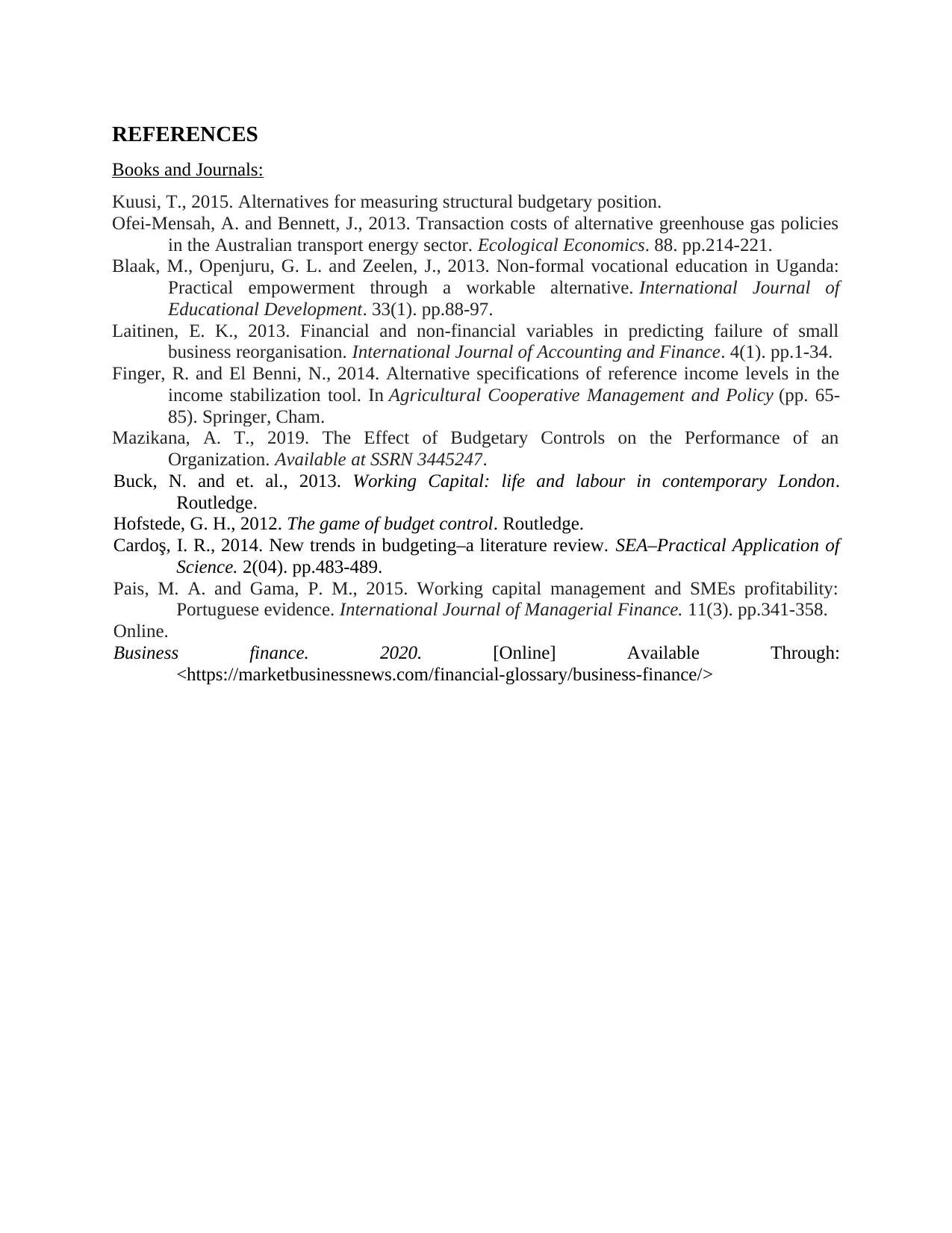
REFERENCES
Books and Journals:
Kuusi, T., 2015. Alternatives for measuring structural budgetary position.
Ofei-Mensah, A. and Bennett, J., 2013. Transaction costs of alternative greenhouse gas policies
in the Australian transport energy sector. Ecological Economics. 88. pp.214-221.
Blaak, M., Openjuru, G. L. and Zeelen, J., 2013. Non-formal vocational education in Uganda:
Practical empowerment through a workable alternative. International Journal of
Educational Development. 33(1). pp.88-97.
Laitinen, E. K., 2013. Financial and non-financial variables in predicting failure of small
business reorganisation. International Journal of Accounting and Finance. 4(1). pp.1-34.
Finger, R. and El Benni, N., 2014. Alternative specifications of reference income levels in the
income stabilization tool. In Agricultural Cooperative Management and Policy (pp. 65-
85). Springer, Cham.
Mazikana, A. T., 2019. The Effect of Budgetary Controls on the Performance of an
Organization. Available at SSRN 3445247.
Buck, N. and et. al., 2013. Working Capital: life and labour in contemporary London.
Routledge.
Hofstede, G. H., 2012. The game of budget control. Routledge.
Cardoş, I. R., 2014. New trends in budgeting–a literature review. SEA–Practical Application of
Science. 2(04). pp.483-489.
Pais, M. A. and Gama, P. M., 2015. Working capital management and SMEs profitability:
Portuguese evidence. International Journal of Managerial Finance. 11(3). pp.341-358.
Online.
Business finance. 2020. [Online] Available Through:
<https://marketbusinessnews.com/financial-glossary/business-finance/>
Books and Journals:
Kuusi, T., 2015. Alternatives for measuring structural budgetary position.
Ofei-Mensah, A. and Bennett, J., 2013. Transaction costs of alternative greenhouse gas policies
in the Australian transport energy sector. Ecological Economics. 88. pp.214-221.
Blaak, M., Openjuru, G. L. and Zeelen, J., 2013. Non-formal vocational education in Uganda:
Practical empowerment through a workable alternative. International Journal of
Educational Development. 33(1). pp.88-97.
Laitinen, E. K., 2013. Financial and non-financial variables in predicting failure of small
business reorganisation. International Journal of Accounting and Finance. 4(1). pp.1-34.
Finger, R. and El Benni, N., 2014. Alternative specifications of reference income levels in the
income stabilization tool. In Agricultural Cooperative Management and Policy (pp. 65-
85). Springer, Cham.
Mazikana, A. T., 2019. The Effect of Budgetary Controls on the Performance of an
Organization. Available at SSRN 3445247.
Buck, N. and et. al., 2013. Working Capital: life and labour in contemporary London.
Routledge.
Hofstede, G. H., 2012. The game of budget control. Routledge.
Cardoş, I. R., 2014. New trends in budgeting–a literature review. SEA–Practical Application of
Science. 2(04). pp.483-489.
Pais, M. A. and Gama, P. M., 2015. Working capital management and SMEs profitability:
Portuguese evidence. International Journal of Managerial Finance. 11(3). pp.341-358.
Online.
Business finance. 2020. [Online] Available Through:
<https://marketbusinessnews.com/financial-glossary/business-finance/>
1 out of 11
Related Documents
Your All-in-One AI-Powered Toolkit for Academic Success.
+13062052269
info@desklib.com
Available 24*7 on WhatsApp / Email
![[object Object]](/_next/static/media/star-bottom.7253800d.svg)
Unlock your academic potential
Copyright © 2020–2025 A2Z Services. All Rights Reserved. Developed and managed by ZUCOL.





